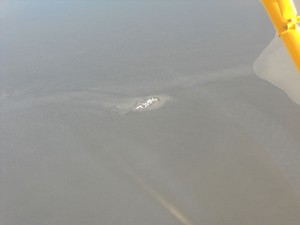Fisheries scientists gathered in Soldotna Thursday for a presentation on years-long study of Cook Inlet Beluga Whales. The information those scientists shared provides a baseline for future studies of Belugas.
Jennifer Dushane has a thing for Beluga whales. She’s a marine biologist based in Anchorage, and she’s one of many scientific minds who came together to produce one of the largest bodies of research yet on Cook Inlet beluga whales.

“The purpose of this study was to provide a first description of this large catalog of records. That included how many [strandings], where were they, when did they occur, by live and dead stranded and by gender and age class when we had that [information],” Dushane said.
Dushane examined records of stranded whales. That’s one of the few areas of study with any real data. Very little exists prior to about 20 years ago, when Cook Inlet belugas were put on the endangered species list. But records of strandings go back to the 1940s. There are two types of strandings reported, live and dead. Dushane found that dead stranded whales were found basically all over the Inlet. But the live ones tended to be more concentrated.
“For the vast majority, when a stranding occurs or stranding events occur in a given year, they generally are occurring in the same area, the same region within that one year,” Dushane said.
Why that is is still up for debate. Like much of the research presented Thursday, it only offers some basic facts, upon which more questions can be raised. Dushane found that June, August and September tended to have the high number of reported strandings. There are a couple likely causes for that. One is that there are more eyes on the Inlet during those summer months. And the other is that strandings are statistically nonexistent in the winter months. We just can’t see them because of snow and ice. Dushane says an increase in reports of dead stranded whales is probably due to the same factors.
“It could be tempting to think perhaps there are more dead whales showing up. But the level of effort at (the National Marine Fisheries Service) to document these strandings has been increasing since the 1980s,” Dushane said. “The public has been getting more well informed about what’s been going on through the media and with the endangered species listing. NMFS has also reached out to the public and informed them about how to report beluga strandings. So the discoverability of these carcasses has probably increased over time.”
Keeping better tabs on what’s washing up on shore is just one angle for researchers.
An oral history was constructed by doing more than 200 interviews with people who had personal experiences in some ways with Belugas. Seeing huge pods of them in Homer years ago, or watching them feed for several days around the mouth of a river. All of those stories went into an exhibit currently on display at the Alaska Sea Life Center in Seward.
Researchers also looked at what is in Cook Inlet that could have some effect on belugas. That includes what they eat, and a variety of hydrocarbons, collectively referred to as PAH.
This work was done by the Cook Inlet Regional Citizens Advisory Council, or CIRCAC. They wanted to see what hydrocarbons were present in the waters of Cook Inlet and where they were concentrated. CIRCAC also studied the prey of belugas for evidence of PAH’s. They looked at beluga blubber and liver samples for those hydrocarbons and found some interesting things.
“Often times, the large, long-lived males show higher concentrations than females, because females periodically get pregnant, and they can dump their toxins, unfortunately to their fetus. Through loss of milk and metabolizing a lot of the fat that they have, they tend to have lower concentrations of a lot of the contaminates,” CIRCAC’s Susan Saupe said.
Specifically, CIRCAC wanted to know what effect the oil and gas industry is having. A lot of these hydrocarbons occur naturally. Like in Kachemak Bay. Even though there’s no industry there, levels are high. Which stands to reason for an area that used to be known as Coal Bay.
But they found the highest concentrations in the industrial zone: that area of the Inlet between the forelands and Tyonek, where lots of drilling rigs are stationed.
They didn’t find much evidence of hydrocarbons in the beluga’s diet. Or at least what they know of as the beluga’s diet. What they eat in the winter remains largely unknown. But salmon turned up mostly clean.
“This study does not show that PAH’s are inhibiting recovery of the stock, but it does raise, we believe, sufficient concern about potential effects to reproduction that warrants further studies, especially on a population where recruitment of one or two whales can make or break things,” Saupe said.
Each researcher ended on a similar note. We’ve learned a lot of very basic information about belugas and their environment. But more research is going to need to be done to get a better handle on what all that information means.
This was the first presentation of all this research and it will be finalized and released as whole later this spring.
Shaylon Cochran is a host and reporter at KDLL in Kenai. He’s reported on fishing, energy, agriculture and local politics since coming to Alaska in 2011. He has worked at KDLL/KBBI on the Kenai Peninsula, where he picked up lots of new hobbies, like smoking salmon, raising chickens, skiing and counting RV’s. He holds a bachelors degree in Journalism from Iowa State University.




